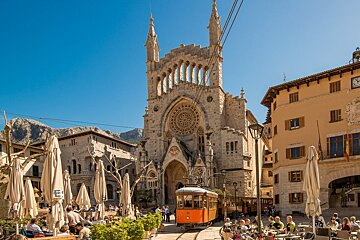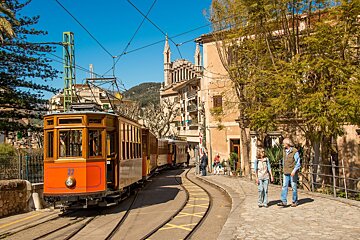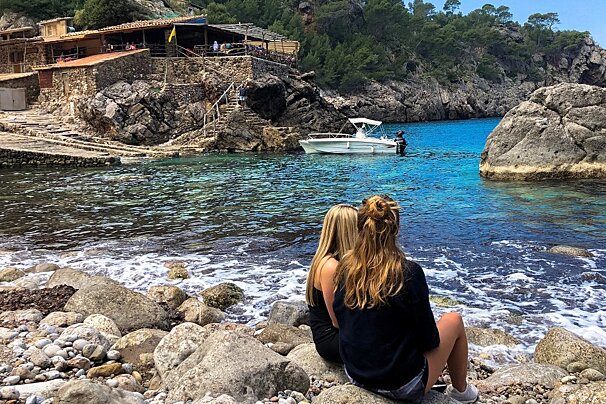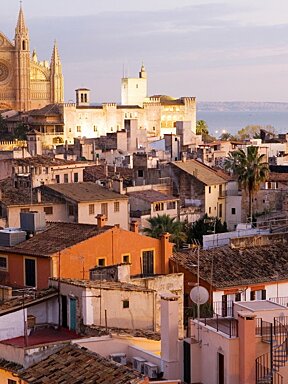
© James Bennett

© James Bennett

© James Bennett

© James Bennett

© Jose Rains

© Jose Rains

© Jose Rains

© Jose Rains

© Jose Rains

© Jose Rains

© Jose Rains

© Jose Rains

© Jose Rains

© Jose Rains

© Jose Rains

© Jose Rains

© Jose Rains

© Jose Rains

© Jose Rains

© Jose Rains

© Jose Rains

© Jose Rains

© J. Rains

© J. Rains

© J. Rains

© J. Rains

© J. Rains

© J. Rains

© [J.Rains]
Soller, Mallorca
Attractive rural town in the west of Mallorca
Set in a lush valley of orange groves between the mountains and the sea, Soller has been popular with day trippers for some time. They tend to arrive on the vintage train from Palma and seem to do little but sit outside the cafes in Plaça Constitució soaking up the atmosphere and the sun. With several tapas bars, a fine selection of pastry shops, local ice-cream, and freshly squeezed orange juice, there is little temptation to move on.
A typical old Mediterranean town, Soller is made up of narrow streets lined with traditional style residential townhouses with the famous green Mallorcan shutters. The main square, Plaça Constitució, has plenty of cafes where you can enjoy a fresh orange juice or coffee, and the area comes alive on Saturdays when the local market takes place. Culture vultures come from far and wide to travel to Soller as it is a place rich in history, full of beautiful architecture and museums. It is also a town that hosts many traditional Mallorcan fairs and festivals throughout the year.
Soller lies a couple of miles inland from its port, Port de Soller. There is a vintage tram that runs from the town to the port, which is one of the most famous attractions for tourists in the area. It’s also really easy to travel between Soller and Palma, thanks to a vintage train, dating back to 1912, that connects the two and travels several times throughout the day. The train journey is an experience in itself as it passes through some wonderfully scenic countryside.
In recent years, a few stylish boutique hotels have opened in the area, making Soller a trendy holiday destination amongst some of the islands most affluent visitors. Although it’s worth knowing that the town remains very much Spanish in terms of its full-time residents and there are very few expats living here year-round, which is perhaps part of its appeal to many.
Watch this
History & Culture in Soller
Soller's early history
Soller has been inhabited by humans since Talayotic times (from 5200 BC), and remains from this era include bronze statues, two of which can be seen in the Museu de Mallorca in Palma. The location of Soller, deep in the Serra de Tramuntana mountains, meant that the town was isolated from the rest of Mallorca and missed out on much of the Roman occupation.
Pirates and other seafaring invaders were always a danger to the inhabitants of Soller, which is why the main town is situated a couple of miles inland from the sea. During the 16th century, Soller suffered repeated attacks from Moorish pirates from Algeria. The pirates were after treasures, as well as women and children. One particular battle in 1561 saw a famous victory for the Sollerics when they repelled 1600 pirates in both Soller and at the Port de Soller. This victory is celebrated every year at the Moros y Cristianos Festival in May when everyone gets dressed up as Moors or Christians and the battle is re-enacted on the beaches in the Port.
The trading boom of the 19th & 20th centuries
During the 19th century, Soller became a major exporter of olives and citrus fruits. The French Revolution had seen a great deal of French immigration to Soller and it was these migrants who utilised their links back in France to build trade relations. With trade came wealth and the creation of impressive manor houses and public buildings, giving Soller an air of grandeur rarely seen in other Mallorcan towns. A stroll to the cemetery above the train station, flanked by cypress trees and filled with potted plants, gives a clue into Soller's history. Several of the epitaphs are in French, revealing the significant French community of the town, descendants of those who came to make their fortune by exporting oranges.
In 1865, a deathly plague struck the orange groves in the valley. Exports declined, public finances were ravaged and many people left to seek their fortunes back in France or South America. The fruit farms gradually recovered and received a boost when scientists discovered the benefits of vitamin C to human health, which created great demand for oranges and lemons.
It was not until 1912 when the rail link to Palma was built that Soller finally began to trade with the rest of Mallorca. The tram line that links Soller to Port de Soller was built in 1914 to help with the transportation of oranges for export. The most recent improvement to the transportation to the rest of Mallorca was the construction of the Soller Tunnel, a 3km road underneath the mountains, in 1997.
Sights & Attractions in Soller
Historical buildings
Soller grew rich on oranges and the results can be seen in its extravagant modernist architecture. The impressive church of Sant Bartomeu dominates the town square and was first built in the 13th century. A Baroque structure was added in the late 17th century and the modernist facade was created in 1904 by the architect Joan Rubid, an ex-pupil of Gaudi. The church also has a 1912 arched tower suspended above the rose window, with spires like huge needles pointing into the air. The same architect designed the equally impressive Banco Central Hispano next door.
Other notable buildings in Soller include La Posada de Ca'n Prohom, an 18th-century civil Baroque residence, La Casa de la Luna, a 15th-century townhouse, and La Posada de Montcaire, an 18th-century Neoclassical residential palace. A walk along Cristofol Colom street will reveal the modernist house Ca'n Nou, while many of the most lavish manor houses built with 'orange money' are situated on the Gran Via avenue. The road Calle Isabel II also has a selection of Modernist and traditional Mallorcan town houses.
Museums
Soller has three museums worth visiting. The Natural Science Museum, in a turn-of-the-century manor house is found on the road to Palma. The museum promotes Mallorca's botany, geology and zoology, and has a collection of fossils. The botanical garden forms part of the museum and is highly recommended. It contains a wonderful selection of flora from the Balearic and Canary Islands. The Museu del Casal de Cultura is an 18th-century manor house in the town centre, filled with antiques and relics of old Soller.
However, one of the most exciting places to visit in Soller is its art gallery, Can Prunera. It features a permanent Modernist art collection with works by national and international artists such as Picasso, Miró, Matisse, Basquiat, Rusiñol, Magritte, Leger and Chillida. The building in which the collection is housed is itself an architectural gem built in 1909-1911. The Modernist facade, beautiful stairwell, murals and glassware are stunning.
Events in Soller
Soller plays host to a great selection of festivals throughout the year. The biggest and best fiesta in the Soller calendar is Es Firo, the Moros and Cristianos Festival which takes place in the second week of May. It commemorates a battle that took place in 1561 between pirates and local townspeople. The festivities include dances and concerts and, most famously, the battle re-enactment taking place on the beaches on Port de Soller. Everyone dresses up as Moors or in traditional Mallorcan costume and there is much celebrating.
June sees a major fiesta, the celebration of Sant Joan or midsummer's eve with bonfires and dancing on the 23rd, while the fiesta of Sant Bartomeu takes place during the week of 24th August.
Things to do in Soller
Other than soaking up the beautiful surroundings of the town and indulging in the town's past, many people come to Soller to enjoy "The Great Outdoors". Being the gateway to the Serra de Tramuntana, Soller is surrounded by beautiful countryside, so it's almost a crime not to be outside to enjoy it. Of course, being so close to the coast, there are boat trips, yacht charters and scuba diving activities available from the neighbouring Port de Soller.
Hiking
Hiking is a major draw for visitors who are spoiled for choice when it comes to trails in the area. You can choose from coastal walks or head deep into the Tramuntana mountain range. The trails are well maintained and signposted. The most famous is 'Dry Stone Route’ which runs from Andratx, in the south, to Pollença, in the north of Mallorca, via Soller and is over 50km in length. Mountain refuges dot the trail so hikers have place places to stay en-route. To see all the best bits, we would suggest using a local hiking company such as Tramuntana Tours or Mallorca Hiking who can arrange all sorts of ways to discover the area.
Cycling & mountain biking
Both road cycling and mountain biking are extremely popular ways of exploring the mountains around Soller. The roads from Soller up into the Tramuntana range provide great challenges for the road cycling enthusiast, with plenty of winding ascents and descents. A guide for mountain biking is particularly recommended as much of the land in the area is privately owned. You can hire all different kinds of bikes and get information on cycling routes from Tramuntana Tours.
Tennis
Tennis is a popular activity in Soller and there are public tennis courts available to rent from the Tenis & Padel Soller Club.
Shopping
Most of the shops in Soller are tailored towards tourists visiting the town, so there are a few gift shops and some lovely delicatessens. Saturday mornings are the best time to come to the town for shopping, as this is when the local market takes place where you can buy arts and crafts, jewellery, clothes, toys, sweets of course alongside local produce.
Dining in Soller
There are plenty of places on the main square to grab a casual snack. However, if you are willing to explore some of the side streets, you can come across some great value eateries. For an authentic Spanish gastronomic journey, we highly recommend Casa Alvaro Restaurant. It serves up good quality tapas, paella, fideua, seafood and some traditional Mallorcan meat dishes.
Ca'n BoQueta continues to receive high praise from customers for its locally-sourced and well-executed cuisine. Look out for the excellently priced set lunch menu (menu del dia). The kitchen team use their creative flair to reinvent traditional Mallorcan dishes, changing the 5-course tasting menu weekly and incorporating seasonal, local ingredients. We recommend booking in advance, especially if you would like to eat in the courtyard. For epic views, head up the road to Ca’s Xorc Boutique Hotel & Restaurant where you will find a table overlooking the Soller valley. The restaurant prides itself on using high quality local and organic products to create a mixture of Mediterranean and international fare.
Hotels in Soller
Soller has a fantastic range of hotels to suit all budgets but has certainly gained some press around its luxury boutique-style hotels in recent years.
Boutique hotels in the town centre
The elegant and highly recommended Hotel L'Avenida offers a contemporary boutique hotel experience in Soller. It has Modernist touches throughout, and the bedrooms feature super comfy beds and funky bathrooms. Here you have the best of both worlds, you can relax by the pool with a cocktail or take a two-minute stroll into the centre of Soller.
The Gran Hotel Soller, a five-star luxury hotel in the centre of town is a lavish affair, it has a spa, a critically acclaimed restaurant, and a fine collection of art throughout the interior. A relaxed and charming option in the centre of Soller is Ca'n Roses which offers tasteful rooms with a boho-chic vibe, a swimming pool, and Bali-style day beds in the gardens. For a quirkier accommodation choice, book your room in Can Coll, which has bright and fresh rooms, a swimming pool and an extensive wine cellar. Perfect for a romantic get-away.
A more traditional town hotel is Hotel Salvia. Set in one of the glorious 19th century manor houses in the heart of Soller, it has breathtaking views of the surrounding mountains. With six bedrooms, a penthouse suite, a pool and pretty gardens, the Salvia has a loyal following with a high rate of return visits.
Countryside fincas on the outskirts
If you'd like to stay up in the hills surrounding Soller, you couldn't make a better choice than Ca's Xorc. The incredible setting affords views of both the sea and the mountains. This rural retreat has 12 romantic bedrooms decorated in a traditional Mallorcan style. The hotel also boasts a highly acclaimed restaurant.
Ca's Curial is a wonderful finca (old farmhouse) that has been lovingly restored to provide spacious bedrooms decorated in a rustic Mallorcan style. Situated on the outskirts of Soller, but only a five-minute walk into town, the hotel offers a swimming pool, gardens and a full dining service. Also on the outskirts of Soller is the pretty Can Quatre, another newly refurbished finca. With a home from home vibe, it offers stylish bedrooms and tranquil gardens surrounding the swimming pool. The perfect place to unwind!
How to get to Soller
By car
Although in the north-west of the island, Soller is easily accessible from Palma airport. Travel towards Palma city coming from the airport, then hop on the Ma-20 motorway, coming off at exit 5A get on the Ma-11 which takes you all the way to the town of Soller.
Public transport
Whilst there are no direct buses to Soller from the airport, you can catch bus number 1 from the airport to the bus station at Plaça d'Espanya in Palma. From there, get the direct 211 TIB which leaves at least once per hour and takes around 40 minutes.






















































